
What Lies Beneath
Five Fascinatingly Frightening Creatures of Elliott Bay
In the deep, dark, cold waters of Puget Sound lurk frightening creatures waiting to strike at hapless prey and pull them into a watery abyss. No, it‘s not the Seattle Kraken! Learn about the fascinatingly frightening creatures that lurk beneath the piers and docks of Elliott Bay. If you dare...

Bluntnose Sixgill Sharks: Cruising in the dark!
In the dark cold waters lurks a creature whose lineage is ancient, predating even the mighty T-Rex, King of the Dinosaurs. Slowly circling in the deep is a predator whose name invokes terror and keeps fish mooooving with fear, the mighty Cow Shark. Well, technically it’s the Bluntnose Sixgill Shark.
Most sharks have five gills while the bluntnose shark has six, hence its name. A member of the cowshark family, they cruise the ocean floor in search of prey including fish, seals, crabs, shrimps, and smaller sharks.
The Sixgill Shark is found all over the world including Puget Sound. They have been observed as deep as 6,000 feet but are commonly found around 300 feet. They are a rare sight in Puget Sound, so if you're diving and you see one, don’t feel scared ... feel lucky!
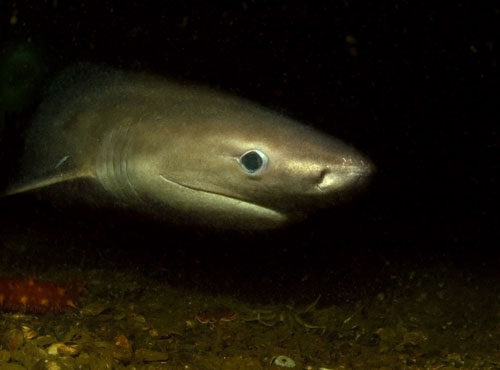
Stats
Common Name: Bluntnose Sixgill Shark
Scientific Name: Hexanchus griseus
Length: Males: 10-11 feet (more than three meters) Females: 11-14 feet (more than four meters); Sharks can reach up to 26ft
Life Span: 80 years (estimated)
Habitat: Atlantic, Pacific, and Indian Oceans in tropical and temperate seas. Adults prefer depths greater than 300 feet. Only comes to the surface at night.
Prey: Fish, seals, crabs, shrimps, smaller sharks
Creepy Facts:
- It has been around since the Triassic Era — its relatives date back over 200 million years ago; the T-Rex is from the Cretaceous Era (around 65 million years ago)
- They have 6 rows of saw-like teeth on its lower jaw and smaller teeth on its upper jaw
Learn More!
- Wikipedia: Sixgill Sharks
- Sea and sky: Creatures of the Deep
- KUOW: Mysterious sixgill sharks in Puget Sound
- Video: Sixgills in Hood Canal

Giant Pacific Octopus: Tastes you with its arms!
Lying in wait in hidden cracks and crevices is one of the most intelligent animals in the ocean, waiting to strike at unwary prey. Darting out to envelope its prey with its eight powerful arms covered in over 2,000 articulated suckers, the kraken grips its hapless victim while using its powerful beak to crush, swallow, or pierce it.
This intelligent hunter is the Giant Pacific Octopus, the largest octopus in the world. The largest one ever recorded weighed 600 pounds and was 30 feet across, although most are only 16 feet across! They have special cells in their skin that give them the ability to change colors and texture to camouflage themselves against the rocks. Since they have no skeleton they can push their body into small nooks and crannies to hide or escape from predators.
The Giant Pacific Octopus is very intelligent, with the ability to use tools, solve puzzles and even open child-proof bottles. In captivity they even learn to recognize the individual humans they interact with.
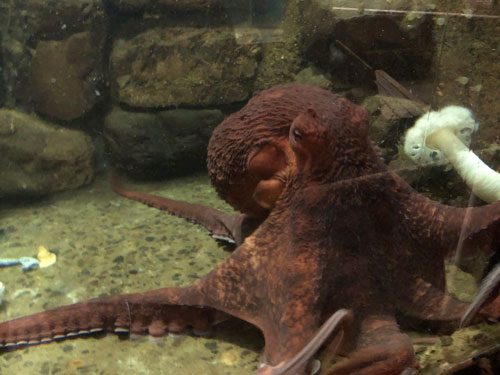
Stats
Common Name: Giant Pacific Octopus
Scientific Name: Enteroctopus dofleini
Length: Up to 16 feet across
Life Span: 3-5 years
Habitat: North Pacific Ocean, in cold oxygenated water
Prey: Shrimp, crabs, abalone, cockles, snails, lobsters, fish, other octopuses
Creepy Facts:
- Each sucker acts independently and is used to taste things they grab
- They hunt at night and grab their prey with more than 2,000 suckers on their eight arms and puncture larger prey with their hard beak
- The females starve themselves to death guarding their 18,000 to 74,000 eggs
Learn more:
- Wikipedia: Giant Pacific Octopus
- Monterey Bay Aquarium
- Seattle Aquarium
- Video: Giant Pacific Octopus Exhibit at the Monterey Bay Aquarium
- Video: Why We're Suckers for the Giant Pacific Octopus

Rockfish : Venomous!
Across Puget Sound you’ll find a family of fish that swims slowly through the water, but hosts two creepy secrets. The first is that even though it looks like a boring normal fish, it hides venomous spines in its dorsal fins. The second is these fish will probably outlive you. It’s a family of animals known as Rockfish.
There are over 100 species of rockfish around the world and 28 are found in Puget Sound. Rockfish are in the Scorpaenidae family and like all members of that family they have venomous spines in their dorsal fins. Unlike their cousins, the stonefish, whose venom is deadly, the venom from rock fish isn’t harmful to humans but can cause a painful sting. Because rockfish venom causes pain and infection, they need to be handled with care.
Many of the species can live well over 100 years, distinguishing it as one of the fish with the longest lifespan. They don’t typically start breeding until later in their lives and this makes them susceptible to overfishing.
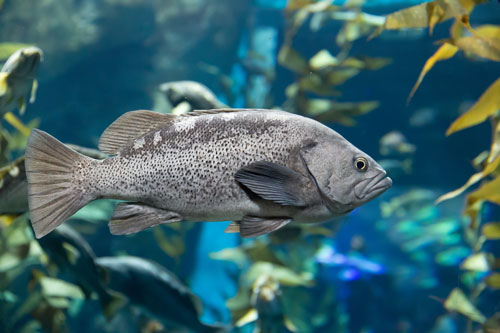
Stats
Common Name: Rockfish
Length: Depending on the species, 3 inches to 3 feet
Life Span: Rockfish can live a long time, some species live well over 100 years
Habitat: North Pacific coastal areas from Japan to California. Depths 40 to 2,000 feet. From rocky areas to kelp and eelgrass beds
Prey: Algae, plankton, jellyfish, squid, shrimp, crabs, fish
Creepy Facts:
- Rockfish are in the Scorpaenidae family and have venomous spines in their dorsal fins. The venom isn’t deadly to humans but can cause a painful sting.
- There are over 100 species of rock fish around the world and 28 species of rockfish are found in Puget Sound
- The oldest known rockfish is estimated at 250 years old.
Learn More:
- Seattle Aquarium: Creature Feature
- Seattle Aquarium: Rockfish Page
- Rockfish Infographic: Seattle Aquarium
- Monterey Bay Aquarium Animals A-Z: Rockfish
- Washington Department of Fish and Wildlife: Species of Rockfish in Washington State

Sunflower Sea Star: Beautiful But DEADLY!
Creeping across the seafloor of Elliott Bay you’ll find a beautiful but deadly predator searching out unwary prey — the Sunflower Sea Star. Sunflowers are beautiful, and so is this multi-armed terror of the sea floor. The Sunflower Sea star may look and sound benign, but if you’re another sea star, clam, or abalone this creature is your worst nightmare. Once you’re in its grip the Sunflower Sea Star will push its stomach outside its body, envelope you, and begin to digest you.
The Sunflower Sea Stars have 16 to 24 arms and are fast and efficient hunters —they’re the cheetahs of the Echinoderm world moving at about one yard per minute on its 15,000 tube feet lining its arms.
Unfortunately the Sunflower Sea Star, like other sea stars in Puget Sound were victims of the mysterious Sea Star Wasting Syndrome in 2013 and2014. The population of all sea stars crashed. The stars develop lesions, and their bodies fall apart and they die. Scientists aren’t sure exactly why this happened, but they suspect a viral infection and a possible link to the rise in ocean temperatures, but there is much more to learn. There are signs that the population is recovering, so some are cautiously optimistic about their future.
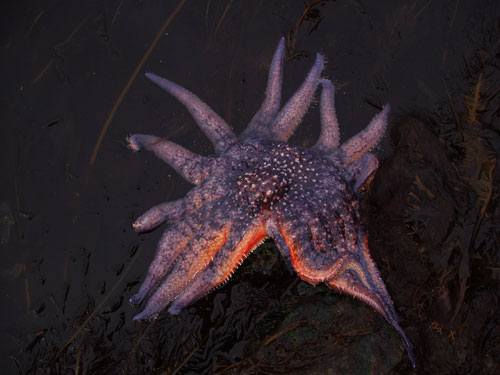
Stats
Common Name: Sunflower Sea Star
Scientific Name: Pycnopodia helianthoides
Length: Up to 3.3 feet
Life Span: 3-5 years
Habitat: The North Pacific from Alaska to Southern California. Subtidal and inertidal areas with kelp and seaweed
Prey: Sea urchins, clams, snails, and other sea stars
Creepy Facts:
- The largest of the sea stars with the most arms.
- The are able to protrude their stomach outside their body to swallow prey
- They have 16-24 arms! And can travel 3.3 ft per min) using 15,000 tube feet on the undersides of their bodies
- They can detach and regenerate their arms as a defense against predators
- When they detach their arms, a new sea star can grow from the detached arm
LEARN MORE:
- Monterey Bay Aquarium: Sunflower Sea Star
- Aquarium of the Pacific: Sunflower Sea Star
- Wikipedia: Sunflower Sea Star
- Cornell University: As Sunflower Stars go, so go the heath of our seas
- Video: Sunflower Sea star: Terrifying Predator? | National Geographic

Wolf Eel: Creepy Crafty Cave Dweller
Peering out of a dark crack in the rocks lurks a strong-jawed predator waiting for a meal to swim by. This fearsome denizen of the deep, the Wolf Eel, rushes out of its hiding place to crush and devour unsuspecting prey.
Though this creature may look fierce, it is actually a curious and surprisingly sweet and misunderstood animal. First it isn’t actually an eel (or a wolf either), but a type of fish. Second, these animals typically are monogamous and mate for life. They aren’t usually aggressive towards humans but their powerful jaws can give you a painful bite, so best to leave it alone.
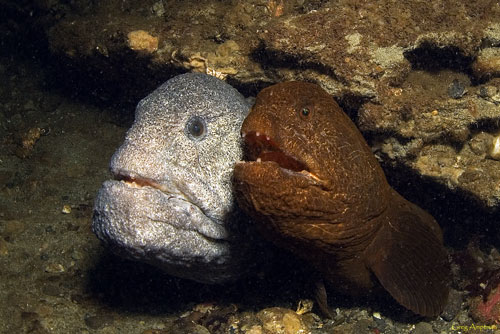
Stats:
Common Name: Wolf Eel
Scientific Name: Anarrhichthys ocellatus
Length: Up to 8 feet (2.4 meters)
Life Span: 25 years
Habitat: The North Pacific from the Sea of Japan to Northern California. Lives in caves, cracks, and reefs up to a depth of 750 feet
Prey: Crabs, urchins, shellfish, snails, abalone, mussels, clams, and smaller fish
Creepy Facts:
- Uses its powerful jaws to crush the shells on crabs, clams, and other shelled invertebrates
- They have a monogamous relationship and mate for life and live in the same cave. One always stays behind with the eggs
Learn more:
- Seattle Aquarium: Wolf Eel
- Monterey Bay Aquarium: Animals from A to Z: Wolf Eel
- Wikipedia: Wolf Eel
- Video Museum of the Pacific: Hugh's Aquarium Views: Wolf Eel Feeding Session

Keep our waters creepy
These five critters, like all animals and habitats in the ocean, are under threat from climate change, ocean warming, and acidification. We all need to do our part to preserve and restore our ocean habitats. The Port is helping to trying to restore and improve the waters of Elliott Bay and beyond. Learn how we’re trying to help:
- Build habitat to fight ocean acidification - Restoring kelp and eel grass beds, the perfect habitat for our creepy critters
- Innovative Idea: Smith Cove Blue Carbon Pilot Project - Using aquatic plants to pull carbon from the atmosphere to fight climate change.
- Five local things you can do to help the oceans - Learn what you can do.
Treats for young animal lovers
- Like these five fascinating critters? Download the printable What Lurks Beneath Critter Cards!
- Learn more about other Creepy Critters of the Port!
- Need more Halloween inspired fun? Download our Creepy Critters of the Port activity and coloring book.




